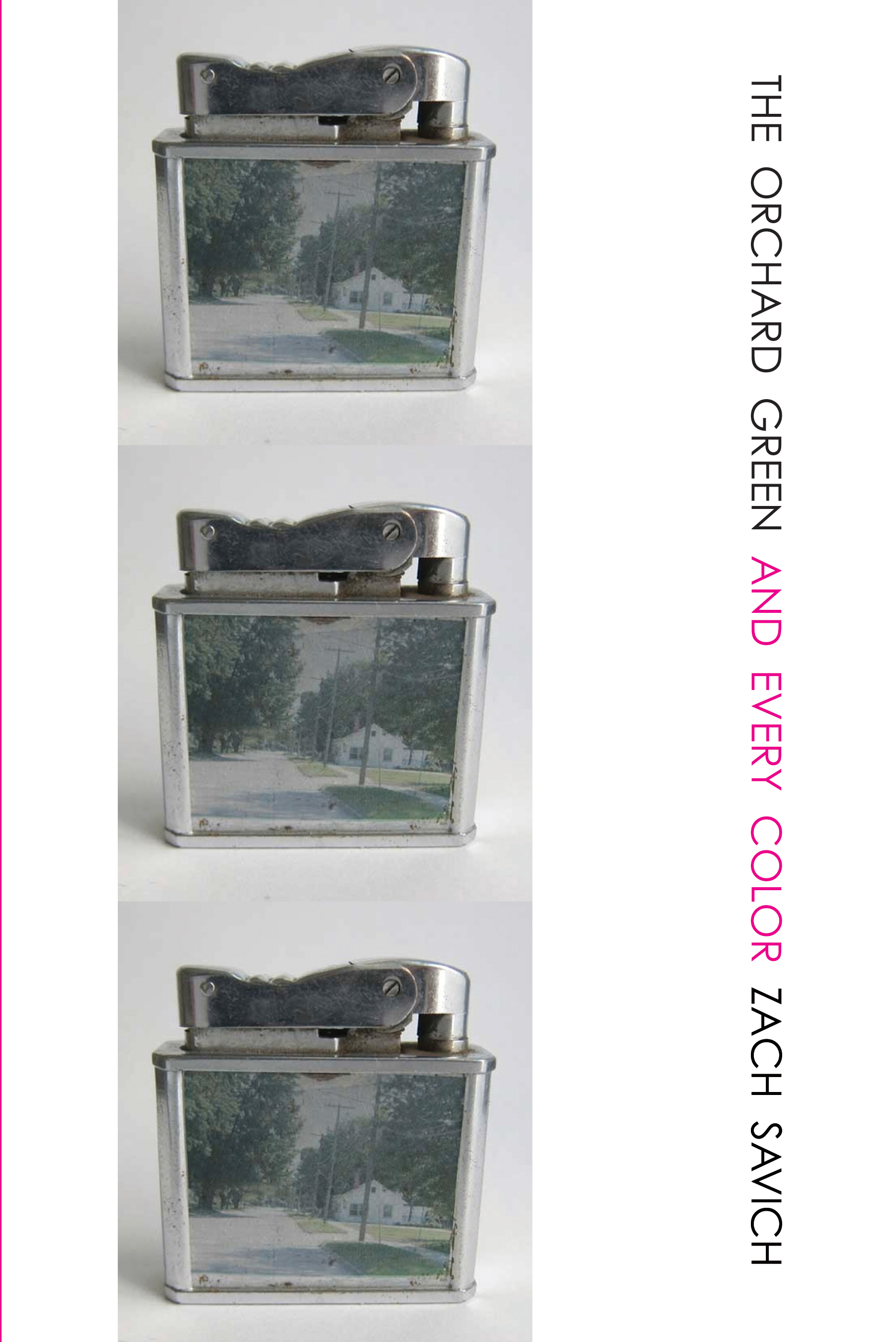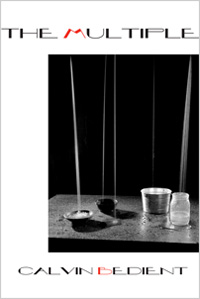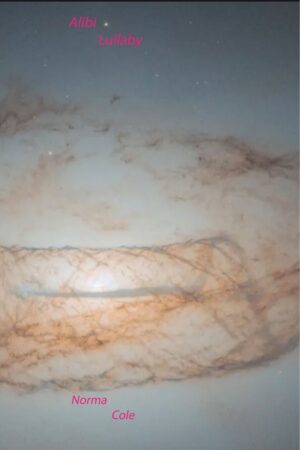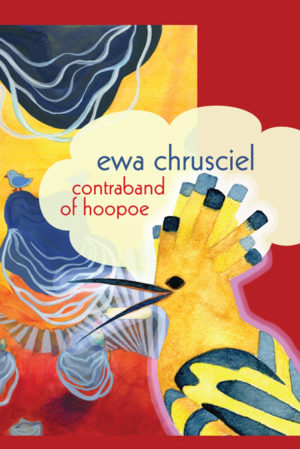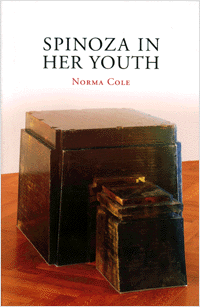Description
In Zach Savich’s new collection, intent seeing makes the present more present. Here clarity is a quality not of logic, but of perception—not of description, but of the landscape itself. The mysteries of grief and joy, of daily desire and loss, resonate fleetingly, a bell struck delicately, struck again. Through his previous four volumes of poetry, Savich has embodied ways of seeing—ardent, fantastical, patient—and voiced the fugitive nature of perspective. The Orchard Green and Every Color builds upon and surpasses that earlier work: in these poems, language is a sense like any other and yet is everything that may be glimpsed and heard and briefly known.
This is the poetry of deep meditation, the meditation of survival, where the perfect knot is a straight thread, a “clothesline is a sentence,” and the definition of quiet is baseball over the radio—and “every death is young.” In living his life with cancer, in hospital or clinic and the world that surrounds them, Zach Savich performs the task of a great poet: he writes down his own elegy, prescribes his language to himself (and to others) in order to see a different year: “the first thing you think/ you’ll never see again/ then see more like it.” To enter this exquisite book is to enter a pact with the poet: “we agree to visit the present” in its lush sundry landscape. And the only promise we make is that “we promise what we are.”
Fady Joudah, author of Textu
In each of us, the life of the self and the life of the world are in some way the same thing–The Orchard Green and Every Color is written from the moment the two separate. It is a lament for the world and the poet’s perspective on the world–but, crucially, not for the poet himself–and thereby manages to be simultaneously as large as the world, and particular and local. And as any true lament must be, it is more about life than death, and enlarges life. The Orchard Green and Every Color is Zach Savich’s best book, and one of the most beautiful books I’ve read in years.
Shane McCrae, author of The Animal Too Big to Kill
Like an epistolary novel from the future addressed to the present as it is falling away, Zach Savich’s tender, intense and beautiful book will break your heart because of how powerfully it loves the life it writes to. Details of the daily are never mundane but hyper-real: three women pray in a supermarket, a man talks tough to his dog, fruit, berries, nuts: this abundance offered and passed through in the briefest of lines: it almost hurts to turn the page. “Anything seen / being outside the body / is plainly ecstasy.” These poems, I want to keep reading them over and over – such startling instances of the real world they address and adore.
Julie Carr, author of Rag
About the Author
Excerpt
Zach Savich is the author of four previous full-length collections of poetry, including Century Swept Brutal, as well as a book of prose, Events Film Cannot Withstand. His work has received the Iowa Poetry Prize, the Colorado Prize for Poetry, the Cleveland State University Poetry Center’s Open Award, and Omnidawn’s Chapbook Prize, among other honors. His poems, essays, and reviews have appeared in many journals and anthologies, including American Poetry Review, Boston Review, and A Public Space. He teaches in the BFA Program for Creative Writing at the University of the Arts, in Philadelphia, and co-edits Rescue Press’s Open Prose Series.
A brief interview with Zach Savich
(conducted by Rusty Morrison)
It is such a pleasure to see this book at this stage in the publication process! Since you first won our first Omnidawn chapbook contest, I’d been hoping to have a book from you. When you offered me this book, I was thrilled. As we have in the description, ORCHARD GREEN AND EVERY COLOR “builds upon and surpasses [Savich’s] earlier work: in these poems, language is a sense like any other and yet is everything that may be glimpsed and heard and briefly known.” Indeed, language is an all-terrain vehicle for every sense’s trajectory, yet you are so deft in keeping it minimal. I see your use of the phrase as a cavity, a ventricle that enacts the muscular movement of meaning. As you say in one poem, “There’s little evidence of the bee’s contact with the blossom/ Outside the blossom”… so much occurs inside the organ that is reader reception. Can you speak to your process in creating this work? Your sense of the phrase, the line?
I began taking poetry seriously while an undergraduate at the University of Washington in 2001. I loved it, from the beginning, because it seemed to be a field in which one could say “I don’t know” and have that be an active, engaged state; poems, as I saw it, could synthesize varied ways of thinking/speaking/knowing while simultaneously letting each of those ways continue on its own, despite contradiction. In one of those first classes, Richard Kenney casually said that poetry is a sensory organ; some years later, I learned Pound’s word, periplum, a term for the view from the prow of a ship, caves or coves coming into view, not from a bird’s eye map. So, I’ve often been drawn to figures for poetry—like the cavity, like the ventricle, like the evidential blossom—that have some form of not-knowing or absence at their core. That not-knowing can be more distinct, I think, if the structure around it is more solid, if the good ship periplum has appropriately billowing sails and winds.
I think this quality of solidity, in The Orchard Green and Every Color, typically comes from attention to present perception that feels, I hope, at once delicate and enduring, momentary and sustained. I often had the word “care” in mind while revising the work—do I care to make an argument with my work, or can care itself be the argument, revealed, as in any garden, by daily labor? To follow that tendril, I was enamored by thinking that the delicate, the fragile, implies worlds of attention that have sustained it—not sheltering or protecting it, but being with it among things, insisting on its survival. “Let it be small enough,” Oppen says; yes, though also, as in love, attention shifts scale.
More specifically, this book emerged from a practice that I also started in Kenney’s class, of keeping a daily journal of observations, of overheard speech and orange peels spiraled in bike spokes, and assuming that those instances, significant if not already obviously meaningful, will accrue further significance when gathered in a poem. As you know, Rusty, the shape of this accruing covered many years. I believe you first accepted the book in 2011, when it was in a much different form—I’d been writing it since 2008 and felt I had gone as far as I could. Your time and conversation and support helped me take it further, as did, in the meantime, the publication by Omnidawn of some books that have been instrumental to my thinking about poetry, including Julie Carr’s Rag and Karla Kelsey’s A Conjoined Book and C. Violet Eaton’s Some Habits. I’m someone who is perhaps too reflexively suspicious of talk of “community” that isn’t about one’s actual neighbors, co-workers, daily relationships; but I feel neighbored by these books.
Your title, ORCHARD GREEN AND EVERY COLOR, asks a reader to pause, to come into a more clairvoyant kind of attention; by speaking of color, a reader is lured to consider ‘how’ we see, as well as what we see, when we perceive. Yet you do so without the slightest nod to an abstraction. As Rosmarie Waldrop says, “perhaps the most important word is ‘and.’” Could you speak to your choice of title?
The most honest answer will sound especially clairvoyant: I dreamt the title and tried to write a book to match it. This seemed worth doing, I think, because of a sense implicit in that “and”— if we believe in logic, “every color” includes “green,” and yet the title makes a distinction, rendering the palette, let’s say, more resplendent, the phrase at once grand and askance. That is, perhaps I’ve never progressed past the dorm room philosophy stage of marveling at how many hues swell in a single expanse of tree.
But I’m glad you mentioned Waldrop; the influence might not seem obvious, but her work has been among the most vital to me since 2005, thanks to a recommendation from Cole Swensen. “Perhaps the most important word is ‘and,’” is such a beautiful phrase, for how it brings us to a threshold (what word will come next?); for how it can suggest, after the thought’s initial pleasure, that the most important word in the statement, perhaps, is “perhaps” itself, moving the notion into a sumptuous torque. And it occurs to me now that “and” offers a way to make an argument not through the shapely conquest of combative logic but by addition, by seeing. With Apollinaire in mind, an early version of the book used a refrain of “there is” for related reasons. Perhaps every act of seeing is a pause. Perhaps every pause is a threshold.
As Fady Joudah tells us in his endorsement, “To enter this exquisite book is to enter a pact with the poet: ‘we agree to visit the present’ in its lush sundry landscape. And the only promise we make is that ‘we promise what we are.’” I remain in awe of the elegance with which you manifest the most excruciating events of our daily lives, and place them alongside the most exquisitely ephemeral. I see the end result, but as a writer, I want to ask about the challenges of creating this body of work. Can you speak to any particular poem, or set of pages, that were a great struggle for you to finish, to find the language for. Were there poems that you gave up on? Poems that changed you in the making, made or remade your meaning for the work? I’d be grateful for any reports from the field of the writing process.
I’m grateful to Fady, as well as to Julie Carr and Shane McCrae, for contributing generously lucid endorsements. These blurbs both became a part of this book and helped me understand it better. The line Fady quotes, about agreeing to visit the present, is also documentary from dream: Jack Christian and I discovered a time machine and were debating where to travel; we finally agreed…
Dreams aside, my process with this book went through several stages. For a while, I thought of little but description, of the ways in which seeing and saying oscillate and twine, of how particulars, closely seen, can both disrupt more reactive habits of thought and carry them further; I was helped along, in these ideas, by essays by Lyn Hejinian and Dan Beachy-Quick. I began trying to write lines like Stevens’ “The bird’s fire-fangled feathers dangle down,” in which gnarly, burling phrases, yeasted with sound and other bright roughnesses, snap precisely into view. Phrases, in other words, that show a process of perception, which includes moments of forestalled or imprecise apprehension; depictions which might take longer to “say” than to “see,” so something happens in that interval. I was probably reacting against recent poetry that, at the time, I saw as being invested largely in the transmission of a kinda solipsistic, imaginative-in-sanctioned-ways, willfully nonchalant posture, one that often established voice through pat declaratives, while neglecting the actual stuff of the world. Poems that offered me much less than most bus rides. I was committed to believing I was in favor of the stuff of the world, despite everything, including the impossibility or difficulty of living/writing truly in such a way; I wanted to write a book that would feel like being in a place.
Because of circumstances, I then started to think often of the afterlife, which is to say I started to think about time. And I started to tell people I wanted to write a poetry of listening, to speak in a way that conveyed or invited a sense of close hearing; I don’t mean through the “active” techniques of a therapist’s parroting, but something closer to how conversation includes so much shared air around any apparent content. That air is the real content? I began revising my knotty depictions into lines that I hoped had the “exquisite ephemerality” that you mention (what a good phrase!), that would be as substantial—rather, as substantiating—as a stepping stone that holds surprisingly well, and so the currents churn further. The process was usually going for a walk and imagining I was talking to someone I know who is dead, and imagining how a poem might become a habitat for that conversation, a setting. When I think of the people I know who are dead, and I imagine them briefly resurrected, I think I’d rather walk with them through my neighborhood than feel the need to confess something of my life or “solve” any dispute.
Could you talk about any writers &/or artists &/or thinkers who have influenced you in this work? (in what direct or indirect ways have you felt this occur?) And/or could you talk about who are you reading currently? With whom do you feel a kinship or a provocation or…?
I spent over ten years reading as much poetry as I could, forming a small corner of what I considered everything. During the writing of The Orchard Green and Every Color, I began abandoning the feeling that I needed to “keep up” with the widest possible scope of poetry; unsurprisingly, this “widest” scope was more circumscribed than I realized, by places, people, history. I began reading more in other areas—starting with recent history and political nonfiction from the years I’d been fixated almost exclusively on poetry.
So, I have a less developed sense of how this book might fit into a poetic/aesthetic/critical vantage than I did with my earlier books. It found its ultimate style thanks to the influence of Donald Revell’s Tantivy and Darwish’s Mural, and there were some poems in Ralph Angel’s Your Moon that helped me write a kind of line that has, I hope, solidity and ease, ecstasy and detachment, rapt to the live instant. Ditto Gillian Conoley’s influence, from books including PEACE and Lovers in the Used World (one of my favorite titles!). Dara Wier, James Haug, Andy Stallings, and Caryl Pagel read and commented on many drafts. Some phrases in the book began as marginalia while I was reading Jorie Graham, Apollinaire, Gustaf Sobin, Virgil, and The Duino Elegies or followed my continual reading of Oppen, Schuyler, and H.D.—I’d triangulate by those three, if I had to know where I was.
As far as provocation goes: my faith is in the lyric. In the ability for lyrical tendencies—intent depiction, affective and associative reasoning, trust in song’s stammering forth, interest in uncertainty, in cosmography over cosmology—to offer what Stevens’ calls an “unofficial version,” which provides us with new ways of seeing and speaking, which we need. Basic ideas? But ones worth insisting on. Often, after readings or during visits to universities, one is asked to justify poetry’s existence, if not to apologize for it, by aligning it with aspects of culture that lyricism is better suited to resist—of media cycles, vocational import, simplified meaning, falsely polarized topicality, foregone spectacle, individual celebrity (who would trust a poet with any celebrity who didn’t immediately write poems to complicate or diminish it?), and so forth. Meanwhile, it’s safe to suspect that poetry has been a part of human life for what I’m happy to call forever. I’m glad that poetry offers an occasion to talk about meaningfulness more broadly, but the calls to justify it by culturally conventional terms—or via those who’d see poetry as a way to individual celebrity, foregone spectacle—seem to suggest an alienation from creative and humane intelligences comparable to asking what the vocational value of bread or clean water is, or why do I stay married if I can’t say what the dominant “meaning” of my relationship is, and anyway aren’t I concerned that my marriage’s audience is limited to the people involved in it, rather than being accessible to the broadest commercial group? Can’t we speak in more familiar ways in bed so everyone can get it without needing to even hear it?
Given this faith, I believe that attending to poetry—to close thinking about lineation, say—becomes a way to attend more closely to the world, to the topical, the mediated, and so forth.
Would you tell me a bit more about yourself? Anything you are willing to share that might not be in your short bio that is published in the book?
Two facets of biography were central to my life while writing this book. First, Hilary Plum and I moved to Philadelphia and I began teaching in the BFA Program for Creative Writing at the University of the Arts, a 2000-student arts school down the street from City Hall. I could go on about why I believe such a program, in such a setting, is distinctly exciting in higher education—in short, I’ve often thought that arts schools (or at least this one) can uniquely advance what we might call traditional goals of the liberal arts, through an emphasis on experimentation and collaboration and contemporary practice and creative thinking more broadly. This position has allowed me to work with a small group of passionate, motivated writers, in a program that launches students into the true wilds of literary work from their first days on campus (my first-year students take a year-long course on contemporary poetry, for example). This setting—among students and colleagues making work in many disciplines; not needing to argue for the existence or value of the arts—has been essential for my writing.
Second, after my father died in January 2013, after several consuming years, I confirmed what I’d suspected: I had the same sort of cancer, the most poetic name for which is “microsatellite instability.” I’ve spent the last three years in treatment or deceptive recovery. Early in this illness, I realized that I needed mental orientations that didn’t rely on metaphors of combat (of “beating” cancer, or having enough “will” to triumph, as though the dead didn’t, as though one can make conventionally willful decisions when thoroughly reduced), since they’d cast my own body as an adversary. Instead, I came to a view—from necessity, from ability, but truly—that emphasized a type of relinquishing, surrender, submission, as though one could surrender enough to merge with and transform an illness or at least to embed it in a wider frame, to live within it. So I’ve let a lot go. What have I not let go? Simply, I hope to live longer so I can hear what my friends say next and so I can continue reading and writing and talking with people about poems. (Next time someone criticizes creative writing programs, please tell them that the outcomes of attending creative writing programs, for me, have been a recorded poem each night from Dan Rosenberg when I couldn’t read; a drive to see trees with David Bartone when walking was hard; a sizable mollusk husk of galactic sherbet from Lisa Wells in the mail; letters from many people I met one time at a reading, worked with one time on a project, offering to do anything to help, meaning it.)
Let me also emphasize: when I mention illness, or death, people often suggest that these experiences will lead me to prefer art that is somehow more truthful because it is more simplistic, more conventional in its beliefs and sentiments, more tied to familiar patterns of experience and its clichés (rather than connecting to an interest in aesthetics/poetics/form/saying something harder than we know how to), but these experiences have made me want only more from art and to believe more heartily that poetry can provide as much as any of us are willing to want. I suppose I try to still want as much as I can.
You were instrumental in the selection of the image that is used in the cover design for this book. Would you describe your process and ideas as you imagined a cover image? How does this cover align with your intentions for the book?
The cover’s main image is by Christina P. Day, one of my colleagues, showing a just-tarnished enough lighter with an overlay of a leafy neighborhood on its surface, an expansive cameo. I’ve admired Chrissy’s work since first encountering it, and I’m thrilled by the ways in which Sharon Zetter adapted it into a design that both matches and furthers my sense of the book. I’m especially pleased by how the image meets the title. The lighter suggests latent fire, for now contained. The trees seen on the cover move the orchard to a neighborhood. The design’s repetition of the image suggests to me a quality of film strip or time lapse—the sense of passing time, represented time, happens mainly in the eye; yet perhaps one thinks about “every color” differently, given the three iterations. And there you can see it, a little white house I would like to live in one day. Or I’d like to picture someone else working in there, the fluid in the closed lighter alive with them, the trees unlit except from a look out the window.
To Love Implies Too Much
I want to mistake freshness for warmth
The physical day awash with larkspur
Everything I remember happened at once
Gold flying in, in summer
So what—it is summer and the leaves are falling
In one version, she grew her hair lushly through the noose
So she could sing a little longer
And the acrobat cut his net into a hundred capes
And all our instruments are green

